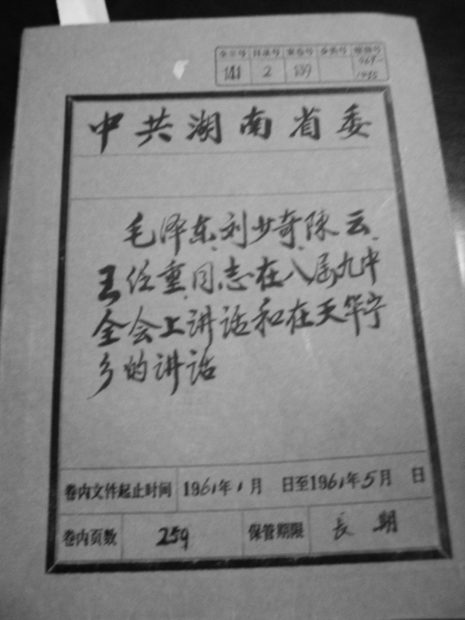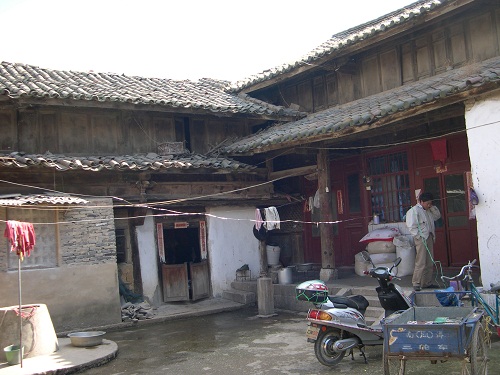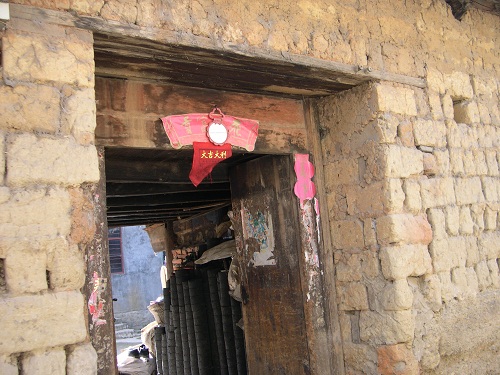|
|
By Zhou Xun
From 2006 to 2010 I worked on a project of key importance to the history of the twentieth century, namely the Great Famine in China under Mao Zedong. The history of the Great Famine in China has long been obscured by official taboos and restricted access to primary sources. Until 1990 very little essential archival material on the subject was available, either to historians or to the general public. In November 1990 the Chinese government published a new archival regulation — which was subsequently revised in May 1999 — which theoretically made available documents older than 30 years to historians and the general public. In practice however, this is not always the case. Today, a great number of documents are still classified as “unsuitable” for public access, and they continue to be deemed “closed” files, while even those files classified as “open” are not always open for access.
As I was researching on the Great Famine, I experienced a number of ups and downs in the archives. When I first started my research in 2006, I could read a huge number of documents, but by December 2007, many of the files I could access before were removed from the catalogue. There was no explanation. In situation like this, my strategy was to move from one archive to another, and hope for the best. To some extent this worked, as accessibility varies from one archive to another, from province to province, and from county to county. It’s curious that in a one party state like China, there exists such variation. In my own experience, sometimes even with letters of approval or rubber-stamped passes given by the archive, the historian is limited in the type of material he or she is allowed to consult. On a number of occasions, the archival staff went through every file I ordered before giving me the green light to read them. The worst experience was in Sichuan provinces’ Ya’an region. I visited a number of county archives, but on three occasions, the archival staff banned me from reading the files I have ordered because the terms ‘death by starvation’ and ‘revolt’ appeared in the document titles. Although in most archives “famine” is still seen as an off-limits subject, there are none the less a fair amount of open documents which can shed crucial light on the period. One term I found useful was ‘grain procurement’. Younger members of the archives’ staff often had no idea what ‘grain procurement’ meant, so they rarely raised their eyebrows when I said I wanted to read documents on the subject. But even this openness changed on the eve of the Communist Party leadership transition, and I will discuss this a little later.
 Comrade Liu Shaoqi’s letter to Comrade Mao Zedong. Dated May 11, 1961. From Hunan Provincial Party Committee archive, file 141-2-139 Comrade Liu Shaoqi’s letter to Comrade Mao Zedong. Dated May 11, 1961. From Hunan Provincial Party Committee archive, file 141-2-139
After the Chinese Communist Party under the leadership of Mao Zedong, overthrew Chiang Kai-shek’s Nationalist government in 1949, the Party inherited a vast amount of archival documents from the previous regimes, include those from the Ming and the Manchu periods and the Nationalist periods. In the early 1950s, the former imperial archive located in the Forbidden City was taken over by the newly established National Archives Agency (renamed State Archive Administration in the 1990s) and administrated by China’s State Council (China’s administrative authority). At that time it was named the First Historical Archive. Meanwhile the archival documents seized from the Republican government in Nanjing were housed in an office under the administration of Chinese Academy of Social Sciences. In 1964, it came under the administration of the National Archives Agency and became known as the Second Historical Archive, but remained closed until 1980s. On the local level each province and county also established provincial and county archives responsible for the safekeeping of local archival documents from the imperial and republican periods. These local archives are under the administration of National Archives Agency. Besides gaining control of the archives of documents from the imperial and republican periods, the Communist Party quickly established the archiving of party documents as an integral part of the party’s attempt to consolidate its newly gained power, and in 1959, the Communist Party Central Committee decided that the National Archives as well as provincial and county archives were responsible for the repository of official party records. Since these records belonged to China’s Communist Party, no individual was allowed access. Many of the local archives were housed inside the local party committee premises, and guarded by armed soldiers.
I began work on the Great Famine project in 2006. For the next four years I travelled across rural and urban China from Sichuan to Hunan, Henan, Anhui, Shandong, Yunnan, Guizhou, Guangdong, Guangxi and many other places to interview Famine survivors and read over hundreds of party records in archives all over China. Through perseverance over years I was able to access party archives that nobody, at least to my knowledge, had been able to see, including top historians from the PRC. By painstaking work in small and large archives throughout China I was able to piece together, from hundreds of fragmented documents, a fuller story of the famine. The Great Famine in China, 1958-1962: a Documentary History, published by Yale University Press (2012) is the labour of my research in those four years. Like Yale University Press’ prestigious Annals of Communism series (it was first established by Jonathan Brett after the collapse of the Soviet Union) which helped to transform the history of the Stalinist era, enriching our understanding of everyday life and health-practice in the USSR under Stalin, this book hopes to transform people’s understanding of what really happened on the ground during the period of the Great Leap Forward and the Great Famine in Mao’s China, and aims to help readers and students to get a much closer and better view of everyday life in Mao’s China, and to understand the complex and individual experiences of surviving under communist rule. The publication of this work will I hope have an impact on an entire generation of scholars.
Since 2009, the majority of the documents included in my book have been deemed “closed files” by the archives. More recently in August 2012, an edict from The State Archives Administration of China (SAAC) in Beijing technically banned any historians from reading archival documents from the period of 1949 to 1979 for the purpose of academic research for “they are likely to publish their research”. In other words, my book may be the only historical record of what happened at the time for the years to come, now that the majority of documents included in my book have become inaccessible, examples of which follow below.
A number of materials included in my book show that the authority in Beijing knew well the extent of starvation and suffering, but they ignored the problems and carried on with the Great Leap Forward nevertheless. Early on in my research I came across a document in Hunan provincial archive on the Luliang Incident in Yunnan province that made a deep impression on me: in January 1958 the Yunnan Provincial government engaged 90 per cent of local population in Great Leap water conservation projects. The goal was to fully irrigate more than 10 million hectares of land in Yunnan within one year. Villagers were forced to work for over ten hours a day, sometimes all night long, and with very little to eat. In February, a major outbreak of edema was reported at Luliang’s Xichong reservoir construction site and a huge number of people died. The local cadre who reported the incident was denounced for undermining the Great Leap Forward. After that no one dared to reveal the truth. The situation quickly worsened. A major famine broke out, and the death toll rose sharply. Soon edema and death became widespread in a number of neighbouring counties, but anyone who dared to report the problem was purged as a ‘rightist’. By August 15th, at the height of the Great Leap Forward, some 169 thousand cases of edema had been reported in Luliang and nearby counties, and nearly 24 thousand people had died. Many families fled the famine.
After reading the report of Luliang incident, Mao wrote simply, ‘This is a good report. The Yunnan provincial government made a mistake, but they have realized that there was a problem, and they have dealt with the problem correctly. They have learnt their lesson, and they will not make the same mistake again. This is a good thing: turning disaster into a blessing.’ At the same time, the central government in Beijing issued an order to make sure that everyone in the country should consume at least 2500 calories a day. Both Mao and the government ignored the crucial fact that there was an endemic famine in the country and that a large number of people were dying. Not long after the Luliang incident, Xie Fuzhi, Yunnan’s provincial Party Secretary at the time who was responsible for the massive starvation and death in Luliang, was promoted to become the Minister of Public Security for China.
 The former Collective Canteen in Shiaipu village, Luliang county, Yunnan province The former Collective Canteen in Shiaipu village, Luliang county, Yunnan province
The other point that the documents I collected demonstrate is that, despite — or perhaps because of their suffering – there was considerable resistance to, and protest about collectivisation and its consequences.Ordinary villagers in rural China used what James C. Scott has called “weapons of the weak” in resisting the Great Leap Forward. A document I read in Sichuan Provincial Archive stating that in 1957, some 400 to 500 people turned up each month outside The Central Rural Affairs Commission in Beijing to oppose collectivization. These petitioners were from 14 different provinces throughout China. When I read a 1960 memorandum from the Communist Party’s Central Committee, tears fell from my eyes. According to this memorandum a poor peasant girl from Henan province wrote a letter to Chairman Mao Zedong complaining about the injustice done by the local cadres to her father and sister. Afraid of persecution, she stitched the letter inside her jacket for over a year.
 Detail of the former Collective Canteen in Shiaipu village, Luliang county, Yunnan province Detail of the former Collective Canteen in Shiaipu village, Luliang county, Yunnan province
Unlike the Holocaust or other major human catastrophes in the twentieth century, there is no place in China’s collective public memory for the Great Famine — the worst famine in human history, which killed millions of people. It is a dark episode very much hidden and forgotten, and there is no mention of it in any history text book in China. The Great Famine has been erased by the official Communist historiography. The accepted term in China for this period is “The Three Difficult Years” or “Three Years of Natural Disaster”. As historians, it is our duty to present to the world what really happened between 1958 and 1962 in China under Mao. The hundred or so documents I have collected and published in my book, all translated into English, will give readers and students a better view of how and why the catastrophe unfolded, as well as the enormity and sheer horror of what took place. In a similar way as the world came to learn the truth of the Katyn Massacre in the 1940s following the revelation of the original execution orders signed by Stalin, by reading these original documents relating to the Famine in Mao’s China, readers can learn that what took place is beyond doubt, and these revelations therefore remove any further opportunity for denials of what happened, or attempts to defend the Great Leap Forward, or arguments for defending an “innocent” Party leadership at the time. Furthermore this book opens a whole new approach in documentary evidence about China under Mao.
Zhou, Xun is author of The Great Famine in China, 1958-1962: A Documentary History, Yale University Press 2012
Extract from The Great Famine in Chine, 1958-1962: A Documentary History:
[blockquote]On April 2, 1961, the then President of China, Liu Shaoqi, embarked on a journey to his home county, Ningxiang in Hunan province, central China. In the course of his route from the provincial capital, Changsha, to his home village in Huaminglou, Liu was increasingly startled by what he saw. The hills which used to be covered in fruit trees were completely barren, and there was nothing except wild grass growing in the nearby fields. Villages along the road looked deserted and the majority of the houses had been torn down, leaving only a few cracked walls standing. The massive pig farm—a Great Leap Forward project—had very few pigs in it and those that were there looked wretchedly thin and unhealthy.
In Huaminglou, his hometown, the President was shattered to discover the damage collectivization had caused. Deeply distressed, he decided to carry out further investigations. On April 12, Liu and his team arrived at Tianhua brigade in Changsha county’s Guangfu People’s Commune. Tianhua brigade was hailed as one of Hunan’s model organizations. It had won many “red flags” during the Great Leap Forward. Liu stayed in Tianhua for 18 days and on May 11 he wrote a long letter to Chairman Mao in which he described the devastation he had found: one third of the houses had been pulled down and 60 percent of the villagers had no homes to return to. Pigs had been killed and consumed by local cadres while many villagers were dying of edema.
http://www.historyworkshop.org.u ... nas-state-archives/
[/blockquote] |
|